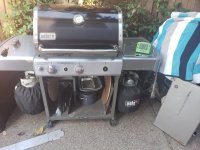Steve Hoch
TVWBB Olympian
Well, I think that's a pretty concrete illustration of why just changing the orifices isn't going to work (properly). Thanks for taking the time to do this Dan!
I think you are right. The smaller hole is for the H temp, and the varying depth of the channel controls the flow of gas.But yes, it does, in that the LO passage is larger than the L hole that it supplies, and the H passage is smaller than the H hole it supplies. So until the spool is rotated to where the H hole aligns with the inlet, the MED flow is metered by the the area where the passages overlap.
It all depends on one's expectations. Because the LO orifice (drilled hole) is smaller on the LPG spool, one will never get a LO temp with an NG spool and LPG, and one will never have much of a MED either, even though the passages are the same on both NG and LPG spools. But if all one care about is how fast it gets hot and how hot it gets, does it matter?Well, I think that's a pretty concrete illustration of why just changing the orifices isn't going to work (properly). Thanks for taking the time to do this Dan!
You're right that it may not matter to some people. It would matter to me because I do actually adjust my burners anywhere in between absolute low and high depending on what I'm cooking and weather conditions. It must also matter to the countless people that jump on here with their conversion nightmares looking for a solution Lol.It all depends on one's expectations. Because the LO orifice (drilled hole) is smaller on the LPG spool, one will never get a LO temp with an NG spool and LPG, and one will never have much of a MED either, because the passages are the same between LO and HI. But if all one care about is how fast it gets hot and how hot it gets, does it matter?
On the other end
I could not agree more, Steve! Precise temp control is crucial! Probably be ok for quick grilling of dogs and burgers, though.You're right that it may not matter to some people. It would matter to me because I do actually adjust my burners anywhere in between absolute low and high depending on what I'm cooking and weather conditions. It must also matter to the countless people that jump on here with their conversion nightmares looking for a solution Lol.
Well, I think that's a pretty concrete illustration of why just changing the orifices isn't going to work (properly). Thanks for taking the time to do this Dan!
I could not agree more, Steve! Precise temp control is crucial!
Yeah, I'm mostly interested in establishing a benchmark. From what others have shared, following a simple orifice change, low temp is somewhere in the low to mid-300s but slowly rising. The majority seem to think that high temps achieved quickly are the yardstick by which to measure a successful conversion, but I think they do a disservice to others who expect a well-behaved controllable grill.I agree, and I more or less expected to find a difference. I'll do a single burner test as Ed asked, and then we can quantify how far off it is.
I agree, however if I need precise temperature control I can use the BGE, the E6 or my 1000
I can easily run 200F to 750F on either the BGE or the E6. I think the low-end on the 1000 is about 225.
I'll see if I can get the steady temp on a single burner test done tonight. I'll have to use a Thermoworks grate probe in addition to my lid gauge.
Ok, installed the LP valve in the center. Left is the converted NG.
Flame on high
View attachment 55174
Flame on low. Pic not so good
View attachment 55175
LP is clearly less flame on low
First test is with the unaltered valve from the LP E330 installed in the center position on the NG Grill. The LP E330 grill is in pieces in the garage.Please clarify: This is originally a NG grill that has been converted to LPG by simply changing orifices, yes? Any additional details about the orifices, like were they from a kit, did they come pre-sized, etc?

And as far as cooking goes, that seems acceptable. Not so much for warming, though, but still, overall, I think it's acceptable.I was going to guess in the 300s, but I thought for sure I was being asked a leading question, that it would be in the 200s.
